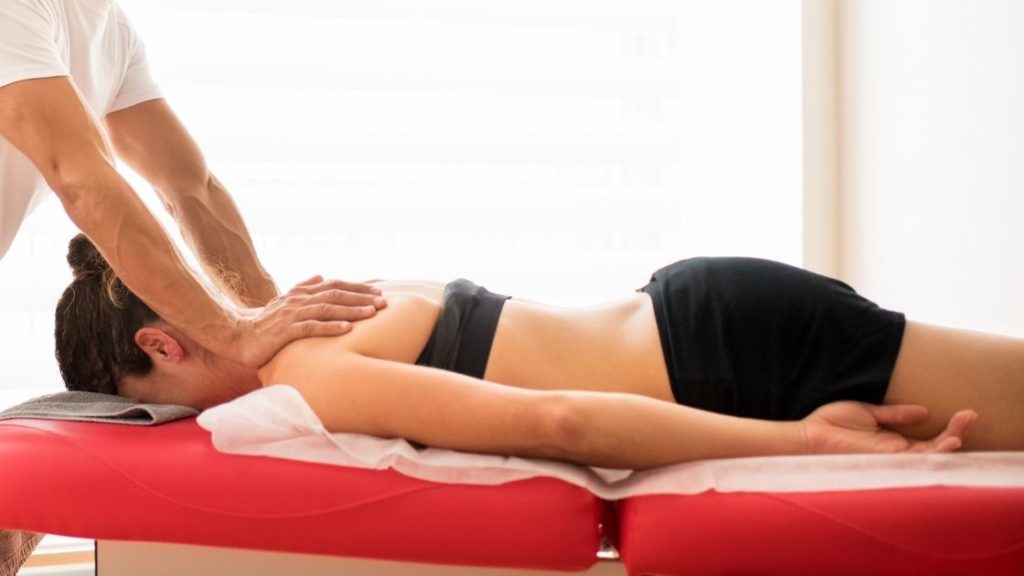What to Expect from Your Myofascial Release Session

Although Myofascial Release (MFR) is a form of bodywork with similarities to massage, it is unique in fundamental ways. For this reason, I will take the guesswork out of it for you and outline what you can expect from an MFR session here at Moyer Total Wellness.
First, we’ll discuss the treatment itself.
What Does a Myofascial Release Treatment Include?
- Pre-consultation
- Postural evaluation
- Proper attire
- Interoception
Pre-Consultation and Postural Evaluation
You may notice that the first session you book will either be 75 or 105 minutes rather than 60 or 90. This provides a buffer zone for a pre and post-consultation. In the pre-consultation your therapist will go over the health questionnaire you’ve filled out before arriving. You’ll discuss any relevant surgeries, injuries, allergies, or contraindications (reasons or areas you should NOT receive MFR). Following the verbal assessment you’ll go through a full body, standing postural evaluation. This isn’t just about you sitting up straight at the dinner table; a postural evaluation is about recognizing areas of imbalance in the body. Are your shoulders level? Is your ribcage rotated? Are your hips even? Because no tissue or joint works in isolation, it is often the case that the area of pain is not the origin of dysfunction. The symptomatic site could be the second or third knot in the line of tangled rope.
The Myofascial Release Treatment
Once the evaluation is complete, you’ll start the treatment. It’s important to note that for an MFR session, you the client, should arrive in loose shorts and a sports bra for women. The entire session will be performed with clothes on, eliminating any anxiety during the movement that will likely be necessary on the treatment table.
During the treatment I encourage you to ground yourself within your body. What does that mean? It means contracting your awareness away from the external world and focusing on the sensations inside your body. This is called interoception. This can be an unfamiliar process for many people with chronic pain because we avoid discomfort. However, if we’ve been living with internal pain for months or years we can’t physically escape, so we mentally avoid by distancing our felt sense within our bodies, or dissociating to varying degrees. It has been shown that interoception can help to regulate emotions during stressful events, improving health and well-being.[1] When this practice is applied during a manual therapy such as MFR, it can increase the benefits of the treatment, reducing the activation of the sympathetic nervous system for greater restoration throughout the entire body.
If you find your mind wandering, the breath is an excellent tether for attention. Slow, deep breathing into your belly soothes the sympathetic nervous system and signals that the body is safe, able to send its energy toward things like digestion and regeneration. Occasionally during the session your therapist might ask you to breathe deeply, narrowing your focus on the area where they are working. We can’t force the body to change, but in this way you and your therapist can gently work together to facilitate change in the tissues.
Now that the session is over, let’s talk about the post-treatment.
Post-Treatment Includes
- Final evaluation
- Hydration
- Exercise
- Follow-up treatments
After the session your therapist may take a few minutes more to assess any adjustments your body made, and areas that require further work. It will be very important for you to hydrate yourself post-treatment. When tissues become bound up they thicken and dehydrate. MFR loosens restrictions, reopening pathways for fluids to travel; however, if no additional fluid is introduced, the tissues are much more likely to return to their restricted state. So drink up!
Gentle exercise such as yoga, walking, or stretching is suitable after an MFR session. Anything that will further enable your interoception is recommended. Though, because it is not unusual to feel drained, a little dizzy, or even emotionally raw post-session, I generally discourage any strenuous workouts or athletic competitions on the same day.
How Often Should You Receive Myofascial Release Therapy Treatment?
So now that your first treatment is complete, how often should you return? If you’ve been dealing with chronic pain for 5 years, one treatment won’t cure you. It’s generally recommended that treatments are more closely spaced initially, then becoming less frequent as symptoms subside and the body rebalances. In the beginning, once or twice a week is not unusual in order to work through habitual holding & guarding patterns in the fascia. A body under the relentless burden of pain is highly sensitized to threat, so rushing in guns blazing will only result in further resistance and defense. MFR offers a gentle and 100% personalized approach to reducing your body’s guarding and returning it to pain-free functioning.
Emily Arnold
Emily Arnold, Licensed Massage Therapist
Emily Arnold is a Licensed Massage Therapist at Moyer Total Wellness. She holds a bachelor's degree in Spanish and Intercultural Studies. But it wasn't until Emily attended the Costa Rica School of Massage Therapy that she really discovered what she was supposed to be doing. She believes the human body is an astounding self-tuning instrument and her goal is to help people achieve homeostatic balance through stress regulation, mindful posture, health education, and intentional touch.
Resources
Price, Cynthia J, and Carole Hooven. “Interoceptive Awareness Skills for Emotion Regulation: Theory and Approach of Mindful Awareness in Body-Oriented Therapy (MABT).” Frontiers in Psychology, Frontiers Media S.A., 28 May 2018, www.ncbi.nlm.nih.gov/pmc/articles/PMC5985305/.
Photo Credit
Canva by photology2000
